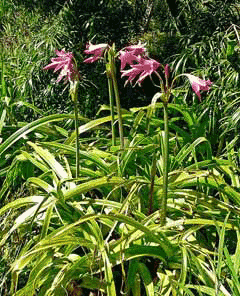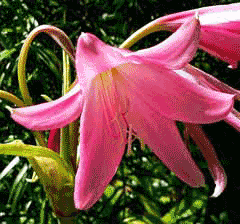 |
|
http://commons.wikimedia.org/wiki/User:Stan_Shebs |
 |
| http://commons.wikimedia.org/wiki/User:Stan_Shebs |
Translate this page:
Summary
Physical Characteristics

 Crinum bulbispermum is a BULB growing to 1 m (3ft 3in) by 0.6 m (2ft).
Crinum bulbispermum is a BULB growing to 1 m (3ft 3in) by 0.6 m (2ft).
See above for USDA hardiness. It is hardy to UK zone 6. It is in flower from June to August. The species is hermaphrodite (has both male and female organs) and is pollinated by Insects.
Suitable for: light (sandy) and medium (loamy) soils and prefers well-drained soil. Suitable pH: mildly acid, neutral and basic (mildly alkaline) soils. It cannot grow in the shade. It prefers moist soil.
UK Hardiness Map
US Hardiness Map
Synonyms
C. longifolium. C. capense.
Plant Habitats
Cultivated Beds;
Edible Uses
Edible Parts: Root
Edible Uses:
Root?? A number of species in this genus have edible bulbs. Although no records have been seen for this species, it is fairly hardy in Britain and the root can be as large as a football. It is worthy of investigation[K].
References More on Edible Uses
Medicinal Uses
Plants For A Future can not take any responsibility for any adverse effects from the use of plants. Always seek advice from a professional before using a plant medicinally.
None known
References More on Medicinal Uses
The Bookshop: Edible Plant Books
Our Latest books on Perennial Plants For Food Forests and Permaculture Gardens in paperback or digital formats.

Edible Tropical Plants
Food Forest Plants for Hotter Conditions: 250+ Plants For Tropical Food Forests & Permaculture Gardens.
More

Edible Temperate Plants
Plants for Your Food Forest: 500 Plants for Temperate Food Forests & Permaculture Gardens.
More

More Books
PFAF have eight books available in paperback and digital formats. Browse the shop for more information.
Shop Now
Other Uses
References More on Other Uses
Cultivation details
Easily grown in a moist soil or the garden border[90]. Requires a rich well-drained soil in a warm sheltered sunny position[188]. Plants are only hardy in the milder areas of the country, tolerating temperatures down to about -10°c[90]. It is probable that the plants may require winter protection with dry leaves or bracken[90]. Bulbs are sensitive to transplanting and may take several years to establish[200]. After this, they will usually reproduce rapidly from offsets to produce the overcrowded conditions that stimulate them to flower freely[200]. The bulbs should be planted with their necks above soil level[233]. This conflicts with another report which says that they should be planted quite deeply in the soil[1]. Only plant out good sized bulbs and do so at the end of May[1]. Members of this genus are rarely if ever troubled by browsing deer or rabbits[233]. The flowers emit a sweet, somewhat spicy odour which is especially pronounced at nightfall[245].
References Carbon Farming Information and Carbon Sequestration Information
Temperature Converter
Type a value in the Celsius field to convert the value to Fahrenheit:
Fahrenheit:
The PFAF Bookshop
Plants For A Future have a number of books available in paperback and digital form. Book titles include Edible Plants, Edible Perennials, Edible Trees,Edible Shrubs, Woodland Gardening, and Temperate Food Forest Plants. Our new book is Food Forest Plants For Hotter Conditions (Tropical and Sub-Tropical).
Shop Now
Plant Propagation
Seed - best sown as soon as it is ripe, placing 2 - 3 seeds in individual pots in a greenhouse. Do not cover the seed. Sow stored seed April/May in a warm greenhouse. Once they have germinated, you can thin each pot to just one plant if required, though we have not found this to be necessary. Give an occasional liquid feed to ensure that the plants do not suffer nutritional deficiencies. Grow them on in the greenhouse for at least their first 2 years, planting them out into their permanent positions in the spring. Division of offsets in April/May or in September. When divided in the spring, the bulbs can be planted out direct into their permanent positions, if done in September, however, they should be potted up and overwintered in the greenhouse.
Other Names
If available other names are mentioned here
Native Range
AFRICA: Lesotho, Eswatini, South Africa (Cape Province, Free State, KwaZulu-Natal, Transvaal)
Weed Potential
Right plant wrong place. We are currently updating this section.
Please note that a plant may be invasive in one area but may not in your area so it's worth checking.
Conservation Status
IUCN Red List of Threatened Plants Status :

Growth: S = slow M = medium F = fast. Soil: L = light (sandy) M = medium H = heavy (clay). pH: A = acid N = neutral B = basic (alkaline). Shade: F = full shade S = semi-shade N = no shade. Moisture: D = dry M = Moist We = wet Wa = water.
Now available:
Food Forest Plants for Mediterranean Conditions
350+ Perennial Plants For Mediterranean and Drier Food Forests and Permaculture Gardens.
[Paperback and eBook]
This is the third in Plants For A Future's series of plant guides for food forests tailored to
specific climate zones. Following volumes on temperate and tropical ecosystems, this book focuses
on species suited to Mediterranean conditions—regions with hot, dry summers and cool, wet winters,
often facing the added challenge of climate change.
Read More
Expert comment
Author
(Burm.f.)Milne-Redh.&Schweick.
Botanical References
200
Links / References
For a list of references used on this page please go here
Readers comment
| Add a comment |
|
If you have important information about this plant that may help other users please add a comment or link below. Only comments or links that are felt to be directly relevant to a plant will be included. If you think a comment/link or information contained on this page is inaccurate or misleading we would welcome your feedback at [email protected]. If you have questions about a plant please use the Forum on this website as we do not have the resources to answer questions ourselves.
* Please note: the comments by website users are not necessarily those held by PFAF and may give misleading or inaccurate information.
To leave a comment please Register or login here All comments need to be approved so will not appear immediately.
|
Subject : Crinum bulbispermum
|
|
|
|